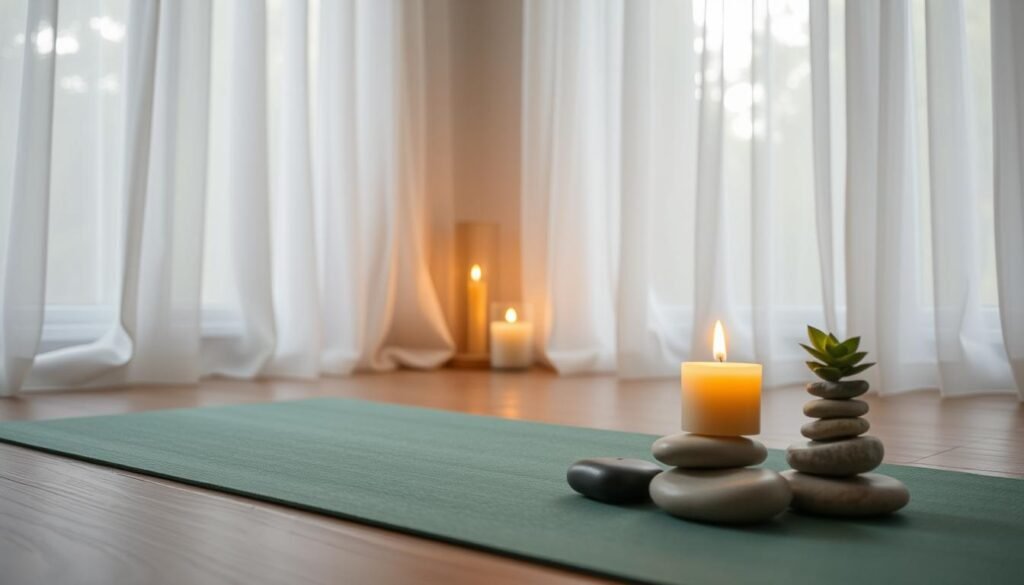Deep breathing can greatly reduce blood pressure and boost your well-being. In our busy world, stress hits millions hard. Yet, guided breathing for relaxation offers a simple, powerful way to cope. Unlike other stress-busters, you can do these exercises almost anywhere.
Guided breathing does more than lower stress. It brings peace and calmness. With regular practice, you can manage stress better and think more positively. These simple exercises fit easily into daily life. For more on breathing techniques, check out guided breathing exercises for relaxation. They can help you find a peaceful mindset.
Key Takeaways
- Guided breathing techniques can significantly lower stress levels.
- Accessible methods like deep breathing can be performed anywhere.
- Establishing a routine with these exercises enhances emotional well-being.
- Relaxation techniques, including breathing exercises, improve overall health.
- Finding the right method is key to effective stress relief.
Understanding the Role of Breathing in Stress Reduction
The role of breathing in stress reduction is very important. When you control your breathing, it helps your body relax. This happens because it lowers a stress hormone called cortisol. When you breathe deeply, you feel calm and relaxed. Your feelings and how stressed you are can be linked to how you breathe. Quick, shallow breaths can make you feel anxious. But slow, deep breaths help you feel better.
Deep breathing is key in many stress reduction techniques. Studies show that it can make your heart rate slow down. It can also lower your blood pressure and help your digestion. Doing breathing exercises regularly can make you feel more focused and happier. It can also give you confidence in stressful situations. One study with COVID-19 patients found that guided breathing helped reduce their anxiety and stress. This shows just how powerful these techniques can be.
Using deep breathing every day can improve your sleep and make you less tired. Knowing how your emotions and breathing are connected helps you manage stress better. For more information on how to breathe to reduce stress, check out this resource.
What are Guided Breathing Exercises?
Guided breathing exercises are special techniques that help you relax and feel mentally well. They can be done through audio, video, or with a teacher’s help. This makes them great for both beginners and those who have done them before.
These exercises come with clear instructions. This way, everyone can do them and feel more peaceful inside. By practicing belly breathing for 20 to 30 minutes every day, stress and worry can be greatly lowered. The approach helps you feel calm and present.

When you do these exercises, it’s important to pay attention to how you breathe. There are suggestions to keep this focus for about 5 to 7 minutes. The 4-7-8 breathing method is one that helps calm your nerves a lot.
In short, these exercises teach you to be mindful. This skill can help you in tough times too.
| Breathing Technique | Description | Benefits |
|---|---|---|
| Belly Breathing | Engaging the diaphragm for deep, even breaths | Reduces stress and anxiety, promotes relaxation |
| 4-7-8 Breathing | Inhale for 4, hold for 7, exhale for 8 seconds | Acts as a natural tranquilizer |
| Pursed-lip Breathing | Inhale through the nose, exhale through pursed lips | Helps those with lung conditions, promotes controlled breathing |
| Resonance Breathing | Breathing in through the nose and out through the mouth for equal counts | Induces relaxation, reduces anxiety |
Benefits of Guided Breathing for Relaxation
Guided breathing brings more than just calmness. It touches various sides of our health, both mind, and body. Practicing often leads us to a deeper relaxation. This opens doors to better focus, stable emotions, and less muscle tension.
Enhances Focus and Clarity
These exercises make our minds sharper. They improve alertness, memory, and how we think overall. More oxygen goes to our brains, boosting clarity and allowing us to focus. This helps us make better decisions and be more productive every day.
Promotes Emotional Well-being
Our emotional health gets a big boost from guided breathing. It’s a key tool against anxiety and depression. Studies show it helps us control our moods better. This is vital for handling sadness and stress. The calm rhythm of our breath soothes our minds, easing stress signs.
Reduces Physical Tension
Guided breathing eases tension in our bodies. Focusing on breathing lets us loosen up and stress less. People notice a drop in chronic condition symptoms, like asthma. And for those dealing with cancer, it shows promising health benefits. This way of relaxing lowers blood pressure and improves heart function, two important health indicators.
Types of Guided Breathing Exercises for Relaxation
There are many guided breathing exercises out there. Each one serves a different purpose in making us feel relaxed and less stressed. They teach us various techniques to handle anxiety and boost our happiness. Learning these exercises can help us find peace.
Deep Breath Exercises
When we do deep breath exercises, we breathe deeply in and out. This method helps us relax fully. By breathing from our diaphragm, we make our breathing more efficient and feel calmer. Studies show that these exercises can make our hearts slow down and lower our blood pressure. So, they’re a great way to deal with stress.
Mindful Breathing Practices
Mindful breathing means paying close attention to our breath. It’s a type of meditation that keeps us focused on now. One way to do it is the 4-7-8 technique. You breathe in through your nose for 4 seconds, hold it for 7, and breathe out through your mouth for 8 seconds. This method helps control how fast we breathe and calms our anxiety. It greatly improves how well we concentrate and make decisions.
Calming Breath Exercises
Calming breathing exercises help us relax by following specific breathing patterns. Techniques like pursed-lip and resonance breathing focus on breathing out slowly and rhythmically. Doing these exercises often can make us feel emotionally better and more stable. For more information on how to relax through breathing, you might want to look at breathing and relaxation exercises.

| Type of Exercise | Description | Benefits |
|---|---|---|
| Deep Breath Exercises | Full inhalations and exhalations to engage the diaphragm. | Reduces heart rate, lowers blood pressure. |
| Mindful Breathing Practices | Focus on breath awareness to ground thoughts. | Improves concentration, anxiety management. |
| Calming Breath Exercises | Structured breathing patterns to promote tranquility. | Eases anxiety, enhances emotional balance. |
Techniques for Effective Guided Breathing
Practicing effective breathing methods can greatly boost relaxation. It also helps to lower stress. Guided breathing is straightforward yet can be life-changing. Below, find ways to enhance your guided breathing techniques.
Counting Your Breaths
For newcomers, counting breaths is a superb starting point. It involves focusing on each breath in and out. People usually count to ten with each breath cycle.
Should your mind wander, just start the count again. This helps stay in the moment. It also makes one more aware of their breathing, making them calmer.
Belly Breathing for Anxiety Relief
Belly breathing, or diaphragmatic breathing, is key for reducing anxiety. It involves taking deep breaths into the belly, not just the chest. Practitioners breathe deep, using their diaphragm.
This method activates the vagus nerve, cutting down stress hormones. Even a few minutes daily can bring inner peace.
Lengthening Exhales to Calm the Mind
To calm down, try lengthening your exhales. It’s about making your exhale longer than your inhale. This practice helps slow your heart, reaching a relaxed state.
Just five to seven minutes daily in a calm place works. Over time, it aids in controlling emotions and thoughts. People often feel more grounded and stable after this practice.

| Technique | Description | Benefits |
|---|---|---|
| Counting Breath | Focusing on inhalation and exhalation by counting | Improves mindfulness and concentration |
| Belly Breathing | Deep breathing into the belly, engaging the diaphragm | Reduces cortisol levels and promotes relaxation |
| Lengthening Exhales | Extending the duration of exhales | Slows heart rate and calms the nervous system |
Guided Breathing Exercises for Relaxation
Guided breathing exercises help manage stress effectively. They mix controlled breathing with relaxation methods for a full approach. People learn to notice tension in areas like their toes, legs, and shoulders.
The 4-7-8 breathing method is a favored technique. You breathe in for four seconds, hold it for seven, and exhale for eight seconds. It’s great for relaxation and can help you sleep faster. Adding these techniques to your daily life can boost your well-being.
During guided sessions, you pay attention to your breath, heartbeat, and body feelings. Being aware like this increases self-knowledge. You learn to tell when your body is tense or relaxed. Depending on how stressed you are, you can change the techniques to fit your needs.
To show how these breathing exercises work, here’s a table with common methods and their benefits:
| Breathing Technique | Description | Benefits |
|---|---|---|
| 4-7-8 Breathing | Inhale for 4 seconds, hold for 7 seconds, exhale for 8 seconds. | Reduces anxiety, promotes sleep. |
| Deep Breathing | Slow and deep breaths focusing on the abdomen. | Improves lung function, reduces blood pressure. |
| Mindful Breathing | Concentrating solely on the breath and body sensations. | Enhances self-awareness, decreases stress. |
Making guided breathing exercises part of your day is good for you. Many use mobile apps to help with practice. This leads to better control and awareness of breathing. These techniques pave the way to less stress and more mental clarity.
Incorporating Relaxation Breathing Exercises into Your Routine
Adding relaxation breathing exercises to your daily life can greatly improve your well-being. It’s important to create a special place for practicing these techniques. This helps you get the most out of your exercises. Pick a quiet spot with dim lighting and soft music to help you relax.
Creating a Comfortable Environment
To prepare your space for these exercises, keep in mind:
- Choose a quiet place free from distractions.
- Utilize comfortable seating or lying positions.
- Incorporate calming scents using essential oils or incense.
- Adjust the temperature to a comfortable level.
This kind of environment not only helps you relax but also makes it easier to practice regularly. Regular practice aids in stress relief.
Setting Aside Dedicated Time for Practice
Setting a consistent schedule is key for adding relaxation breathing exercises into your routine. Make sure to pick certain times in the day for these practices. It could be:
- Starting the day with five minutes of deep breathing.
- Taking short breaks every few hours to practice paced breathing.
- Incorporating breathing exercises into evening routines to unwind.
Practicing regularly can bring big benefits like better focus and less stress. Taking time to concentrate on your breathing can clear your mind and boost your performance.
Overcoming Common Breathing Challenges
Guided breathing exercises often come with common breathing challenges. Some people find their mind wandering or feel restless, which can make practice hard. Recognizing these difficulties is the key to overcoming them. Using gentle reminders to focus on breathing helps. Techniques like progressive muscle relaxation improve effectiveness and address anxiety.
Adding different breathing techniques to your practice helps tackle these problems. For example, overcoming anxiety through breathing is possible with certain methods:
- Diaphragm Breathing: Doing diaphragm breathing three or four times daily for 10 minutes can lower stress and anxiety significantly.
- Resonant Breathing: Practicing resonant breathing for 10 minutes can ease anxiety and foster relaxation.
- Lion’s Breath: Repetition of this technique up to six times can help release tension.
- Alternate Nostril Breathing: Completing up to 10 cycles, with each lasting about 40 seconds, helps restore balance.
Using guided meditation recordings can also interrupt ongoing stressful thoughts. This strategy fosters mindfulness and calm, key for handling common breathing practice challenges.
Being consistent is vital for mastering breathing exercises. It takes time and dedication to build meditation skills, especially those focused on breathing. Regular practice keeps you focused and deepens relaxation technique skills.
| Technique | Time Required | Focus |
|---|---|---|
| Diaphragm Breathing | 3-4 times a day, 10 minutes each | Reduce stress and anxiety |
| Resonant Breathing | Up to 10 minutes | Calm anxiety |
| Lion’s Breath | Repeat 6 times | Release tension |
| Alternate Nostril Breathing | 10 cycles, 40 seconds each | Restore balance |
Finding the Best Guided Breathing Resources
Looking for guided breathing resources can make relaxation better. With many types available, one can find the best fit to decrease stress and better their health.
Apps and Online Tools
Using breathing apps is a fresh way to do guided breathing. Apps like Headspace offer sessions for various needs. These apps provide audio meditations, visual guides, and different time options to fit busy lives. This means you could pick a short 3-minute session or a longer 19-minute one.
The UCLA Mindful app is also great, with meditations in many languages. This helps more people try guided breathing. These apps are on iTunes and Google Play, so you can practice mindfulness anywhere.
Classes and Workshops
Joining workshops for relaxation provides real-life practice and community connections. Local classes have live teachers which can improve learning and keep you motivated. Instructors show different breathing methods, like belly and box breathing. Participating lets you share stories, get tips from others, and improve your guided breathing skills.
In conclusion, the right guided breathing resources can make relaxation and stress management more effective. Whether it’s through apps or classes, there’s something for everyone.
How Guided Breathing Techniques Support Stress Relief
Guided breathing techniques help reduce stress by both physical and mental effects. By practicing regularly, these exercises become natural responses to stress. This helps people relax when they feel stressed. Adding these exercises to your daily routine is easy. They don’t take much time but are very beneficial.
These exercises help slow down your heart rate and lower your blood pressure. This helps manage stress. They also improve your mood and brain function. Using visualization, like picturing yourself calm, with “I breathe in peace and calm”, makes these techniques even more powerful.
Guided breathing is flexible. You can do it standing, sitting, or lying down. This makes it easy to practice anywhere. For the best effect, do deep breathing exercises for 10 to 20 minutes. This helps you relax and reduce stress the most.
| Technique | Details | Recommended Duration |
|---|---|---|
| Deep Breathing | Inhale for 3 counts, exhale for 6 counts | 10-20 minutes for maximum relaxation |
| Box Breathing | Inhale, hold, exhale, and hold for 4 counts each | 3-5 minutes |
| Progressive Muscle Relaxation | Tighten and release different muscle groups | 10 minutes |
| Alternate Nostril Breathing | Inhale and exhale through each nostril in specific sequences | 5-10 minutes |
By using guided breathing every day, people can enjoy many benefits. It offers a way to improve well-being and manage stress.
Conclusion
Guided breathing exercises are key for stress relief. They make you feel better by lifting your mood and lowering anxiety. These methods also help you relax. Studies show that taking slow breaths and sighing in cycles can improve how you feel physically and emotionally. This builds a strong base for handling stress over time.
Trying different guided breathing techniques lets people find what works for them. This might be box breathing or the 4-7-8 method. It’s crucial to keep practicing to get the full benefits. These benefits last longer than just a moment of peace. They can change how you see life and improve your emotional health. You can learn more about how these methods work in this study.
There are many breathing exercises to choose from. This means everyone can find a method that suits their lifestyle. The proof shows starting with a few minutes of focused breathing each day can lead to better stress management. It’s a simple way to get healthier.